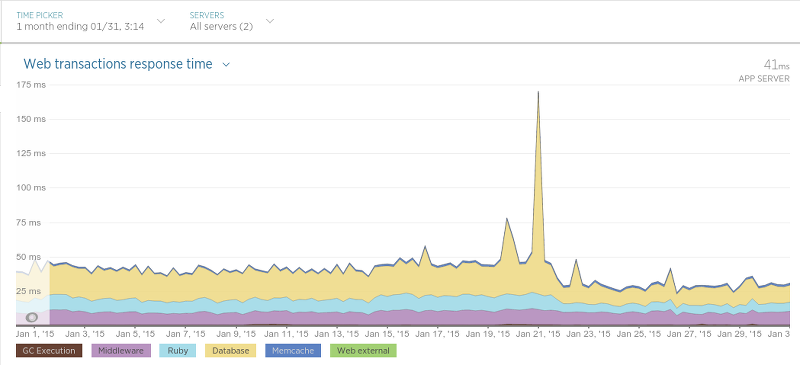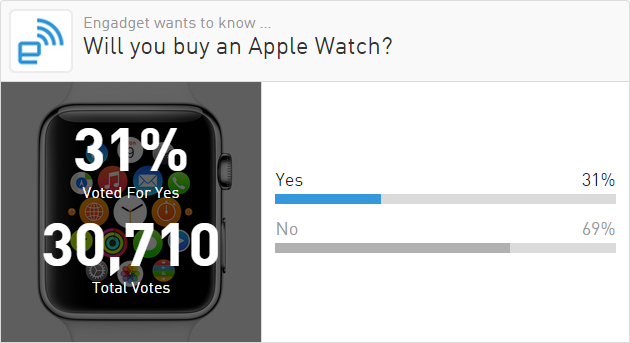Sections
Pick of the Week – Apple Watch
Apple finally launched the Watch revealing a range of 38 variants from entry level to the high end luxury 18ct Gold Edition which will cost up to $17k:
“Apple’s smartwatch collection will range in price from $349 to $17,000 (£299 to £13,500 in the UK) depending on the metals they are made from and the straps they are bought with.”

Much of the post-launch focus has been on that price range given the electronics and software will be the same across all variants. A Gold Edition will not function any differently from an entry level version Watch leading to the realisation that Apple has now redefined itself as a luxury brand with all that entails:
“Apple has sought to establish itself as a luxury company for years. It has. This is what a luxury company looks like, a gold-encrusted, ultra-elegant, ritzy-priced cross-stitch of fame and rare earth materials. In Apple products, everything is better. Steel isn’t just steel, it’s Apple Steel, multiples better than the other junk. A table isn’t a table, it’s a custom Apple Watch showcase display. … In this event, Apple’s fulfilling the the past two years of media prophecies and definitively establishing itself as a luxury brand for the rest of the world. .. Today we saw, for the first time, a new, secondary Apple model, one that is moving on the opposite end of the wealth spectrum. Ten thousand dollars, that’s a starting point. Wearing the finest Apple Watches of the future will be a privilege indeed.”
https://youtu.be/dDAP9OWtQro
A target market for the Gold Edition exists and the product will make Apple lots of money irrespective of what shocked observers may think. The focus on gold is specifically tuned to China where use of the colour and material is still an important sales driver. But that isn’t really the point. Rather, as Benedict Evans suggests, the raison d’être for the Watch is to serve as a “self-funding marketing operation” enhancing brand value like Apple Retail and, if you follow that logic, there’s an argument that the Watch might not be expensive enough:
“In the rarefied world of luxury, obsolescence is a feature, not a bug. The fact that the Apple Watch will be obsolete in a year or two makes it even more desirable to the luxury consumer. In fact, the quicker it becomes obsolete, the better.
It’s an ostentatious display of wealth — and tech folks can’t wrap their brains around it. It’s not practical. But the tech matters not. It’s almost irrelevant.”
Luxury is ultimately about how a product makes one feel and that is the real direction of future travel for Apple, namely personal technology. It starts crucially with the retail experience where we can expect many changes to Apple’s current “one size fits all” store approach in the coming years.
In the light of a clear assault on the Swiss luxury watch niche, it’s instructive to read what industry insider Hodinkee has to say about the positioning of Apple Watch within the luxury watch cost spectrum:
“Few casual consumers break the $10,000 mark for mechanical watches — this is usually left for either the extremely wealthy or the extremely dedicated. “
Apple Watch pricing analysis seemed to overshadow functional considerations. However, Apple clearly invested a huge amount of multi-disciplinary engineering effort to bring its health and fitness features alone to life:
“We needed to study the conditions in which the device would be worn and build expertise on how to measure all-day activity and exercise. At the scale we sell our product, we couldn’t just use off-the-shelf algorithms. We needed to build our own knowledge base from the ground up. In many ways, the health and fitness research and testing we have done is historic. We’ve studied more people, in more conditions than most university research has ever done”
Also in terms of Apple Pay integration:

As to the question of whether anyone will buy it at any price, here are the results of a sample Engadget poll:
Devices and Manufacturers
- For many commentators, the real surprise at the Apple event this week wasn’t the Apple Watch but the new super-thin sub 13.1mm 12 inch MacBook. It seems to be positioned to supercede the MacBook Air with its fanless board, “contoured batteries”, redesigned keyboard, Retina display and single USB-C connector.

- The Economist on how smartphone ubiquity has turned us into Phono Sapiens on the Planet of the Phones.

- Mark Shuttleworth reckons that Ubuntu’s phone future is “more exciting that space travel“:

- Meanwhile, back on earth, TechCrunch found Ubuntu Phone still needs a lot more work to represent any real threat to the status quo:
“As it stands, Ubuntu mobile’s gesture story comes across as confusing, and when the core aim of having a ‘buttonless’ interface is apparently to save people time, that seems contradictory. A more realistic narrative is this is a device aimed at Ubuntu’s core user-base who won’t be put off by a little layered complexity. And who want to extend their support for Ubuntu open source from desktop to mobile.”
- VAIO is no longer part of Sony and “has decided to go up against its former parent company’s Xperia series with its own creation“, a middle of the road Android 5.0 smartphone:

Google and Android
- Google formally announced Android 5.1, the MR1 update to Lollipop and duly provided access to the corresponding platform source available at android.googlesource.com.
- They may also be working on a version of Android to run in VR headsets. There’s certainly no shortage of initiatives in Google. The Kernel provided this handy summary of several key “moonshot” projects being run out of Google X including the typically wackily named Project Loon, Project Titan and Project Wing:
Apps and Services
- Another good post from Benedict Evans explaining why although both iOS and Android have “won” the smartphone developer war generating $billions of revenue in the process, iOS will always have the best looking apps. It’s all down to addressable device range form factor variation.
- Layer are an OTT messaging platform provider. They have just launched an open source library called Atlas to allow startups to rapidly integrate messaging functionality into their mobile apps. It sounds like a potentially very compelling proposition if it works as readily as claimed:
“The sales pitch for Layer was that any app could add messaging with just 10 lines of code. For startups who haven’t launched, Layer is free.”
- Shazam will apparently soon be able to recognise objects as well as music:
“The company says its app will soon let users identify products and learn more about them. For example, you could point your phone at a cereal box to get in-depth nutritional information, or at a DVD case to buy the soundtrack from your device.”
- Skype meanwhile could do with focussing on improving its core feature set. TechCrunch suggest it has become increasingly unreliable bringing into question the whole Skype for Business push:
“It’s 2015, and Skype remains a tenuous experience. For a tool that is so globally liked, and used, it’s an odd situation.”
- Corgi is an app that puts Feedly on your Android lock screen:

Asia
- Fortune published a great must-read survey of the dynamic and entrepreneurial Chinese smartphone scene. The article profiles OnePlus, Xiaomi, Meizu, ZTE and Huawei and provides many fascinating insights into a frenetic and perhaps surprisingly cosmopolitan and colourful new world.

- TechInAsia provided an outline the 15 most well-funded SouthEast Asia startups. There’s a strong focus in the list on eCommerce.
Big Data, Cloud and Devops
- Alibaba’s cloud computing arm Aliyun are “testing the water” by opening their first US data centre.
- This excellent Twitter engineering blog post outlines how they have architected their Answers backend to cope with an incredible 5 billion sessions a day. The ingestion pipeline is built on AWS and employs a Kafka cluster to cope with the volume of events coming in. Apache Storm is used to shuttle this torrent into S3 storage:
“To reduce impact on the device, we send analytics events in batches and compress them before sending. .. This communication protocol results in devices sending us hundreds of thousands of compressed payloads every second. Each of these payloads may contain tens of events. To handle this load reliably and in a way that permits for easy linear scaling, we wanted to make the service that accepts the events be dead simple.”


- InfoQ post on how adopting a microservice-based architecture can help minimise business impact by reducing lead time, namely “the time from when an opportunity is discovered until a solution is created“.
- Interesting insight into DevOps within the UK Government Digital Service (GDS):
At GDS, developers have a lot of autonomy. They are responsible for their application’s whole lifecycle. Developers deploy to production from their own laptops and support their own code, including on-call rotations. They also make their own tech choices.
- Also in the UK, brand analytics leader DataSift have just been given the keys to Facebook’s castle in a major validation for their sentiment analysis technology. The two have collaborated to launch a Facebook Insights product called Topic Data for US and UK customers:
Brands issue the queries through a third-party analytics provider that submit them to DataSift, which can run them against Facebook’s data. DataSift hands the analytics tool back anonymized statistical data that it can form into charts or insights.
- Topic Data is anonymized but the mining of social messaging on behalf of brands is nonetheless going to be controversial for some:
Still, the idea that their private status messages to friends will fuel better ad targeting may irk some Facebook users. There’s no opt out, and the only way to keep data totally private is to set posts to be visible to “only me”, or not post at all.

Tech blogging and blogging tech
- GigaOM, one of the world’s top tech blog sites was abruptly shut down this week apparently as a result of cash flow problems. Their own announcement was grim and very much to the point.
- This recipe detailing how to integrate WordPress into Slack was verified with the import digest blog this week. Today the “Email Subscriber” WordPress plugin is used to provide simple blog mailing functionality. This handy TNW summary of options for email newslettering highlights some alternatives for improving on that.
- Rob Charlton provided a helpful recipe for web hosting using Docker and Vagrant on AWS. The same approach should one day also be broadly applicable for the import digest blog too.
Software Development
- Interesting real-world perspective on the subtle problems that can emerge with a MongoDB cluster in a large production system. In this case issues with performance and lack of schema combined to encourage a migration to PostgreSQL with demonstrable improvement in web transaction response time:

- The current state of JavaScript may be a headache for developers but knowledge remains very much in demand as the language “will continue to expand and take charge of an increasing number of digital responsibilities in varying parts of the stack“. This InfoQ article surveys the current scene pointing out its limitations and suggesting routes for gaining DIY JavaScript skills from Codecademy to Pluralsight:
“Your career advancement, marketability and compensation are in your control now more than ever.”
- This entertaining rant on the “secretly terrible engineers“ that lurk in every company makes some good points. Weeding such candidates out seems to be the core motivation behind many tech hiring strategies but to little avail it seems. The article points out that it’s more important to focus on helping good developers learn new skills:
“If people are wired for engineering logic and have programmed in some capacity in the past, they almost certainly can get up to speed in any other part of the field. Let them learn, or even better, help them learn.”
- On the subject of tech hiring, this excellent thought-provoking post suggests we would benefit from consistency of process and a focus on work samples and performance within a work environment rather than interview performance.
- Julia Ferraioli’s first work experience in software engineering makes for essential, if deeply depressing and disturbing, reading and raises questions about attempts to get more women into coding given what they’re going to find there. Clearly there’s a long way to go to address equality in the tech working environment and arguably the advent of smaller, less mature organisations has made progress even more challenging from an HR perspective. One remedy outlined to the problem of workplace bias here involves blind interviews which underlines the need for a robust and consistent hiring process. The only problem is how, as in Ferraioli’s case, you address those who are already in the company..
“A new developer’s (especially a junior dev’s) first run experience within a job are the ones they’re going to remember for the years to come. The gravity of that responsibility should be treated with respect. Given that women in tech leave the field in droves, it’s clear that as a whole, the industry doesn’t give enough thought to the first impression that it has on developers entering the field.
So, before we congratulate ourselves for filling the “pipeline” with diverse candidates, let’s ask ourselves what they’re going to face in the workplaces we’ve created.”

- Nick Carr, contrarian as ever, highlights a study by the US National Bureau of Economic Research that suggests that we’ve reached “peak code” and that the current demand for software developers may also fizzle away as automation disrupts the very people responsible for disruptive software today. It’s a dystopian perspective on the meme that open source is ultimately doing us all out of a job:
“As usable code stocks swell, the model indicates, we will at some point pass the cycle’s point of peak code — the moment of maximum demand for new code — and the prospects for employment in programming will begin to decline. Code boom will turn to code bust. (The bust will be even deeper, the economists found, if software is distributed as open source and hence made easier to share.) Even though high-tech workers “start out earning far more than low-tech workers,” they “end up earning far less.””
Wearables and the Internet of Things
- Wired have a fascinating exclusive on the making of the Disney MagicBand, an “invisible” wearable designed to guide your DisneyWorld visit and make it unforgettable. Development of the MagicBand was shrouded in secrecy, took years and cost $1billion. It’s clearly a huge deal for their future and given their unique standing with children, Disney are in a truly special place to innovate in terms of service experience:
“For Disney, the MagicBands, the thousands of sensors they talk with, and the 100 systems linked together to create MyMagicPlus turn the park into a giant computer—streaming real-time data about where guests are, what they’re doing, and what they want. It’s designed to anticipate your desires.”

- Disney offer a great example for other companies on how the Internet of Things can be used by brands to create better engagement with their customers. Five use cases for initial consideration revolve around providing users with rewards, information, facilitated payments, better services and innovation.

- In the future brands will also be able to reach and literally touch their customers with the advent of expressive haptics addressable through web services. This BBC article provides some interesting background in the form of a smart glove that allows a user to communicate using the Lorm alphabet (touch Braille):

- Haptics could eventually go a lot further than glove communication. This article on the current state of “sexbots” explores some of the territory – warning it’s probably not entirely safe for work.
- Apple hide the same electronics inside all their Watch variants. This open source binary wristwatch outs them for display along with a multicoloured ribbon connector for a strap:

- This rotary phone has been converted to VOIP using a Raspberry Pi:

- And sticking with the retro modern theme, a Bluetooth keyboard that looks like a Sinclair ZX Spectrum:

- The BBC is planning to give away one million “Micro Bit” computers to get Year 7’s (specifically girls) coding:
“It’s going to be a small, standalone device with an LED display that children can carry around with them and plug into a computer to continue their work. .. The project is still in a prototype phase, but the BBC claims it’ll be ready to give away one million of the new microcomputers to year 7 students this autumn.”

Technology Startups
- Genomics is transitioning from the lab to the market and this is reflected in rising VC investment in genetic tech companies in the US. Many of these companies share the view that the human genome is merely code. Today the bottleneck is in processing and parsing this code. Ultimately however such a viewpoint logically leads to the view that the code can be modified through biotech engineering to create “synthetic biology“:
“A human genome has 3 billion base pairs — it’s helpful to think of it as 3 billion lines of code. The sequencing instrument reads 50 lines of code at a time, and you have to read each line 30 times … so you get this giant pile of data, and it’s still largely unintelligible until it goes through a secondary analysis”
- In an age of iterative capital and myriad small-scale crowdfunded initiatives, it’s almost refreshing to hear of a Leviathan of the funding scene. Solidworks ate through $64 million of seed funding to create the ultimate meta product:
Onshape, which launched in public beta today, is an eye-popping product. Product designers can now edit and share their CAD designs across computers, and even more amazingly, across devices. All in the browser. All in real-time.

- A endemic fear of failure in the enterprise leading to an inability to innovate is a topic covered in this blog last year. A superb corollary to that is this post from Steve Blank, one of the leading advocate of the Lean Startup. In it he emphasises that it is critical for businesses to separate out core execution risks from innovation risks and use different methods and teams to pursue these two activities. Blank’s key points:
- Accepting failure and running at speed are part of an innovation culture.
- We need to separate out innovation risks from execution risks.
- There are now proven Lean innovation methodologies that we can use off the shelf in building an innovation culture without inventing our own.
- We need to make sure that management no longer uses execution metrics to manage and judge our innovation teams.
Work and Culture
- Is there such a thing as being “over-connected”? It’s a question explored in the context of a photo exhibition of people in public on their phones which has within a very short period of human history become completely normalised without real examination of the implications:
“even if you don’t buy into the hypothesis that my phone is effectively a handheld piece of my mind, it’s hard to ignore the mounting evidence around human cognition’s vulnerabilities.”



